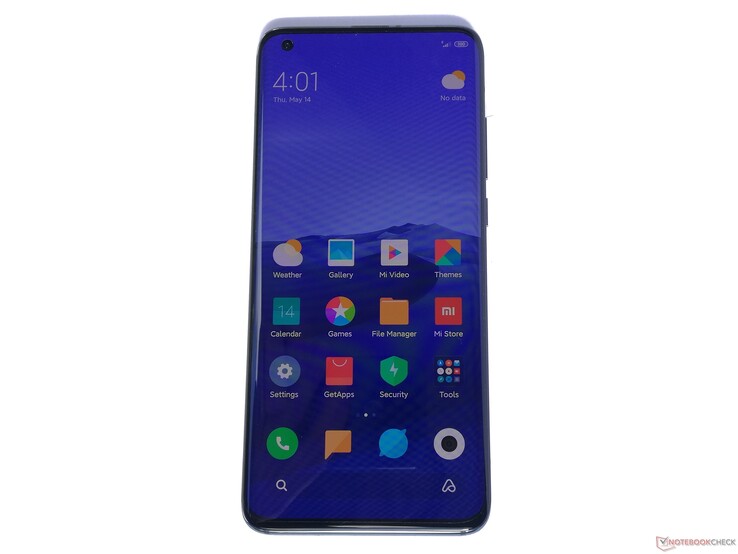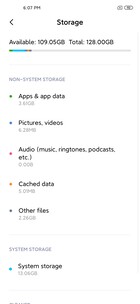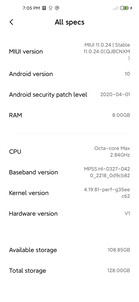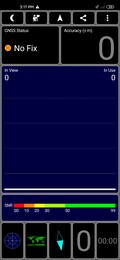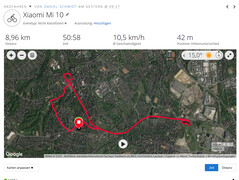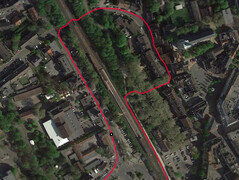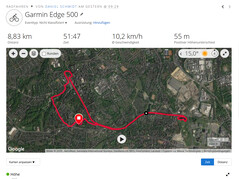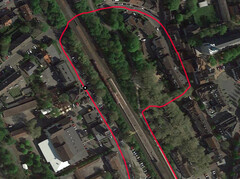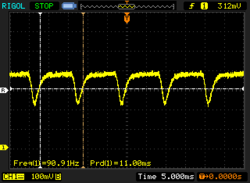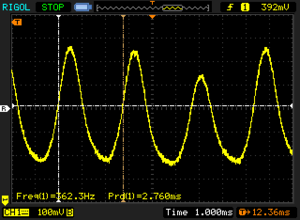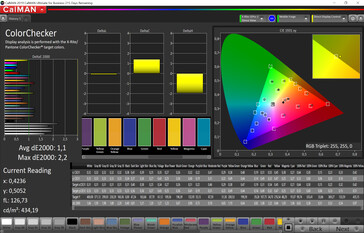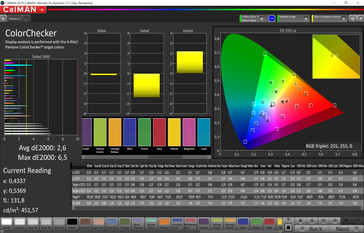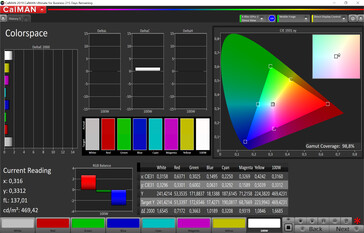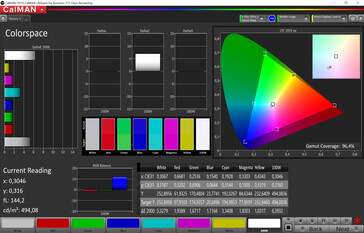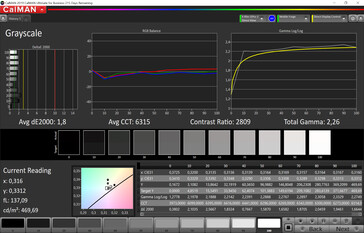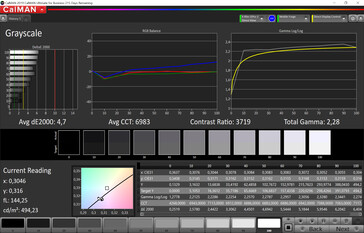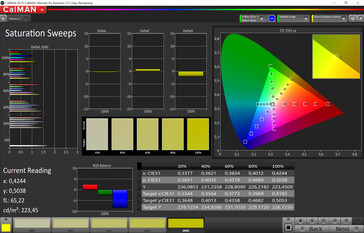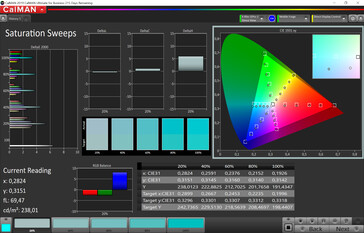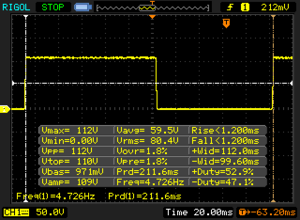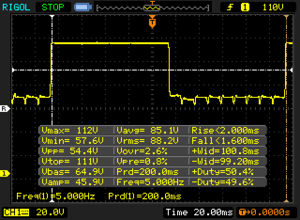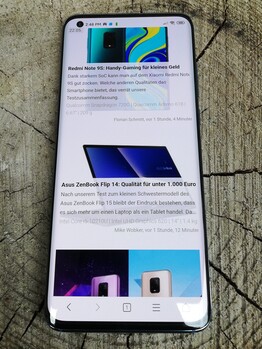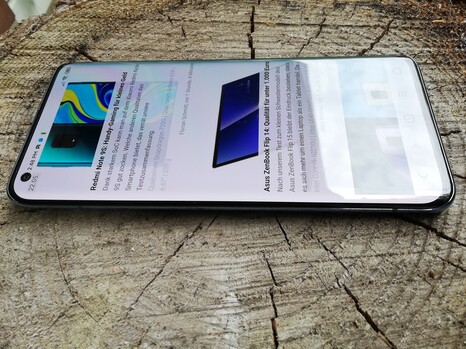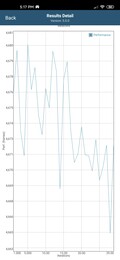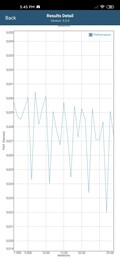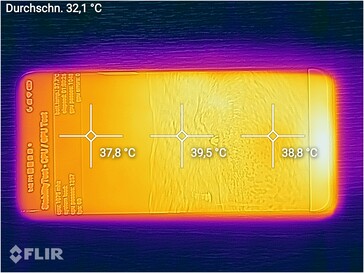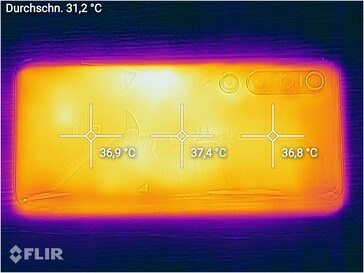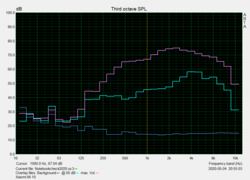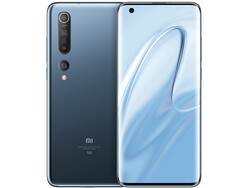Xiaomi Mi 10 Smartphone Review: More Megapixels
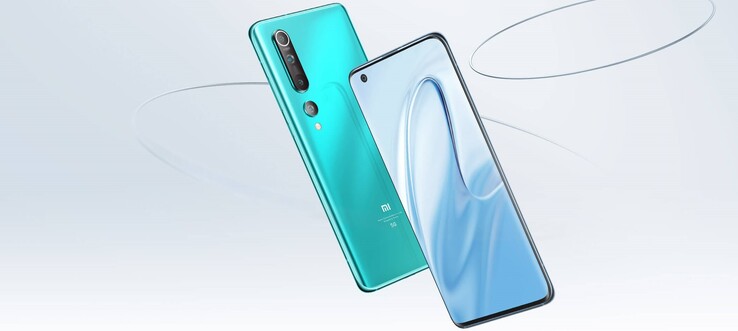
In our test of the Xiaomi Mi 10 Pro, the manufacturer was already able to prove that it is quite able to build smartphones in the top-end segment. However, at a price of almost 1000 Euros (~$1090), the costs were also elevated to new dimensions. Now, the Xiaomi Mi 10 wants to bring most of the qualities of the flagship model into a slightly more affordable sphere for "only" 800 Euros (~$872; currently around $690 in the US).
The SoC, the amount of RAM, and the display diagonal remain the same, and the design has hardly changed either. However, users of the Mi 10 have to make do with slightly less internal storage, and except for the 108-MP main sensor, the camera equipment is also slimmed down. We compare the Mi 10 with the competing devices listed below, and you can also add more models from our database underneath each of the segments.
Comparison Devices
Rating | Date | Model | Weight | Drive | Size | Resolution | Price |
|---|---|---|---|---|---|---|---|
| 87.8 % v7 (old) | 05 / 2020 | Xiaomi Mi 10 SD 865, Adreno 650 | 208 g | 128 GB UFS 3.0 Flash | 6.67" | 2340x1080 | |
| 86.1 % v7 (old) | 03 / 2020 | Oppo Find X2 Pro SD 865, Adreno 650 | 202 g | 512 GB UFS 3.0 Flash | 6.70" | 3168x1440 | |
| 88.5 % v7 (old) | 04 / 2020 | OnePlus 8 Pro SD 865, Adreno 650 | 199 g | 256 GB UFS 3.0 Flash | 6.78" | 3168x1440 | |
| 87.7 % v7 (old) | 03 / 2020 | Samsung Galaxy S20 Exynos 990, Mali-G77 MP11 | 163 g | 128 GB UFS 3.0 Flash | 6.20" | 3200x1440 | |
| 87.4 % v7 (old) | 04 / 2020 | Huawei P40 Kirin 990 5G, Mali-G76 MP16 | 175 g | 128 GB UFS 3.0 Flash | 6.10" | 2340x1080 |
Case - A high-quality smartphone from Xiaomi
The front of the Mi 10 is dominated by the dual-edge display. It is curved on both sides, transitioning into a metal frame that goes around the whole smartphone. On the left top, the front camera is positioned behind a punch hole in the display, and the slim earpiece is above the top edge. On the glass back, the raised frame of the camera sensors - four in total - appears very hefty. The Mi 10 does not offer an IP certification or anything similar.
At a weight of 208 grams (~7.3 oz), the Xiaomi smartphone is the heaviest device in our test field. As for its measurements, it does not quite reach the height of the OnePlus 8 Pro and the Oppo Find X2 Pro.
Equipment - Mi 10 without a notification LED
The Xiaomi Mi 10 is run by a Qualcomm Snapdragon 865 and 8 GB of RAM. Those are accompanied by a Qualcomm Adreno 650 graphics unit and 128 GB of UFS-3.0 storage. While the smartphone does not offer a storage card slot, you can insert two LTE capable nanoSIM cards. 5G is also supported, but we were unable to test this, due to a lack of the corresponding network coverage.
There is a USB Type-C port for wired data transfer, which is connected internally with the USB-2.0 standard. There is neither a 3.5-mm audio port nor a notification LED. Instead, the Mi 10 offers an infrared sensor and DRM Widevine L1. The Camera2 API is available with Level 3 support.
Software - Chinese MIUI version
Xiaomi delivers the Mi 10 with Android 10 and the in-house MIUI 10.0.24 stable version. Those who are familiar with Android will get along well with the latter. However, there are quite a lot of apps for the Chinese market on our test unit, which need to be uninstalled by the user if they don't want them and replaced by the corresponding localized app.
Google's frameworks are supported by default, so that you can for example manually download and install the Play Store fairly easily. However, users need to plan on spending some time and researching if they have purchased a version of the Xiaomi Mi 10 that is meant for the Chinese market.
Xiaomi also sells the Mi 10 in Germany with a global software version that directly includes all the Google Services.
Communication and GPS - Well suited for navigation
The Xiaomi Mi 10 is able to connect to the GSM, 3G, LTE, and 5G mobile networks. In addition, there are Bluetooth 5.0 and NFC for close range communication.
In wireless networks, the Android smartphone is able to support Wi-Fi 6 (802.11ax). With our Netgear Nighthawk AX12 reference router, the smartphone reaches 903 Mb/s on average when receiving and 867 Mb/s when transferring data. These results are sufficient for a place in the upper middle of the field of our selected comparison devices.
| Networking | |
| iperf3 transmit AX12 | |
| Huawei P40 | |
| Samsung Galaxy S20 | |
| OnePlus 8 Pro | |
| Xiaomi Mi 10 | |
| Oppo Find X2 Pro | |
| iperf3 receive AX12 | |
| Huawei P40 | |
| Xiaomi Mi 10 | |
| OnePlus 8 Pro | |
| Samsung Galaxy S20 | |
| Oppo Find X2 Pro | |
With the GPS Test app, we evaluate how well the Mi 10 is able to determine its location. To do this, the Xiaomi smartphone can use GPS, GLONASS, Beidou, and Galileo, and we were able to reach an accuracy of up to four meters outdoors. However, we were unable to determine our location indoors.
In our mandatory bike tour, the route recording of the Mi 10 is even slightly more accurate than that of our Garmin Edge 500 reference device. The Android smartphone is therefore well-suited for navigation tasks.
Telephone Functions and Voice Quality - A clear connection with the Xiaomi Mi 10
Xiaomi uses its own Phone app in the Mi 10, which offers everything users would expect from such an app. After starting the app, it displays a dial pad and the numbers that were dialed last. There is also a tab with the stored contacts. During a call, the conversation partners can be heard loudly and clearly, and background noises are filtered out reliably.
Cameras - More megapixels do not make better pictures
The Xiaomi Mi 10 comes with the same 108-MP main sensor that is also offered in the Mi 10 Pro. However, the rest of the camera elements have a lower resolution, so that buyers of the "regular" Mi 10 have to make do with 13 MP for ultra wide-angle recordings and 2 MP each for macro recordings and depth information. On the other hand, with 20 MP, an f/2.0 aperture, and 0.9 µm pixel width, the front camera offers the same features as that of the Mi 10 Pro. Portrait recordings succeed correspondingly well, being able to convince with vibrant colors and many details. Aside from various beautification modes and filter options, as well as an HDR mode you can activate, users cannot manually influence the recordings.
Photos taken with the main camera succeed with an attractive quality. However, the blurring effect for the background sometimes looks too strong, and higher zoom levels produce some very clear graininess in the whole recording. The ultra wide-angle lens is able to capture the selected objects with pleasing colors. Details can still be recognized easily, but blurry edges become noticeable at low zoom levels. The same quality is also achieved by the 5x zoom of the Xiaomi Mi 10, which is able to deliver acceptable recordings with this. In bad light conditions, the Mi 10 is able fully reproduce our test object and with only slightly distorted colors. While you can still clearly see some coarse graininess, the image quality increases dramatically as soon as there is a better light source. For recordings with the front camera, there is also a Pro mode, which allows you to adjust the white balance and offers settings for focus, exposure, ISO value, and brightness.
Video recordings are created with a similarly good quality as also demonstrated by our test photos. The camera also handles fast movements and changes between light and dark areas well. In addition, the image stabilizer ensures a stable recording. For resolutions of 1080p and 4K, you can also adjust the frame rate to 60 fps. In slow-motion mode, videos are recorded in 720p and 1080p resolution and at 120 fps. The camera app also allows you to select an 8K resolution. However, when you select that, the AI of the smartphone determines the rest of the settings.
Using the ColorChecker Passport, we evaluate the color reproduction of the camera of the Xiaomi Mi 10. It shows that the colors are brighter than they should be. On the other hand, in extremely low light conditions of 1 Lux, they turn out too dark, but still remain recognizable.
Under controlled light conditions, the Mi 10 is able to reproduce our test chart well. However, we can again see the slight graininess in the zoom detail. At only 1 Lux, this effect becomes even more pronounced, but compared to other smartphones the Mi 10 still offers a very good reproduction performance in bad light conditions.
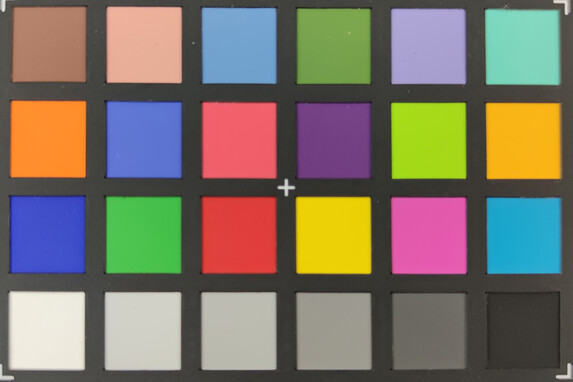
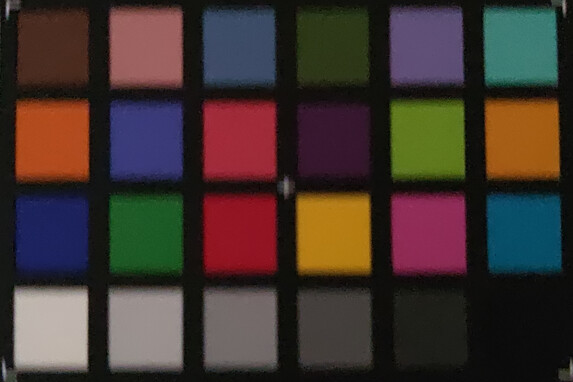
Accessories and Warranty - Protective cover included
The box of the Xiaomi Mi 10 includes a USB charging plug with the corresponding USB Type-C cable and a protective silicone case. Since our test unit came from TradingShenzen, a charger with a US plug was included. However, the vendor will also include the corresponding plug and USB Type-C to Type-A cable at no additional charge.
Buyers of the Mi 10 receive a warranty of 12 months on their device.
Input Devices and Operation - A great touchscreen feedback
The keyboard app of the Chinese Mi 10 version offers a multitude of adjustment options that we are unable to describe because of our lack of knowledge of the Chinese characters. We therefore recommend installing a locally adjustable keyboard app after buying the smartphone. The touchscreen accepts inputs very well and also responds with an extremely pleasant vibration. Drag-and-drop as well as swipe movements work very well. The position sensor also responds to movements of the smartphone very directly.
To unlock the phone, you can either use the fingerprint sensor integrated into the display or FaceID. While the fingerprint sensor needs a bit of time to get used to, in order to learn the correct placement of the finger for it to be recognized directly. Face recognition worked slightly better, but the standby screen still has to be swiped up after unlocking, in order to show the start screen.
Display - A bright OLED screen in the Mi 10
The screen of the Xiaomi Mi 10 consists of a 6.67-inch AMOLED display with a 90-Hz refresh rate that is protected by Corning Gorilla Glass 5. With an average brightness of 791 cd/m² it is able to lead our test field. While the brightness distribution is good at 96%, it is not quite as good as those of the competitors. Without the active brightness sensor, the maximum brightness drops to 491 cd/m², and the lowest brightness that you can adjust it to is 2.07 cd/m². The APL50 test shows a small surprise with the Mi 10 achieving an outstanding brightness value of 1003 cd/m².
As customary for OLED displays, the Xiaomi Mi 10 display also flickers. In the 90-Hz mode, the frequency is slightly higher at 362.3 Hz, and at 60 Hz it drops to the usual 250 Hz. Via an anti-flicker mode, you can also add DC dimming, which might ensure a more comfortable image for users with sensitive eyes.
| |||||||||||||||||||||||||
Brightness Distribution: 96 %
Center on Battery: 786 cd/m²
Contrast: ∞:1 (Black: 0 cd/m²)
ΔE ColorChecker Calman: 1.1 | ∀{0.5-29.43 Ø4.77}
ΔE Greyscale Calman: 1.8 | ∀{0.09-98 Ø5}
98.8% sRGB (Calman 2D)
Gamma: 2.26
CCT: 6315 K
| Xiaomi Mi 10 Super AMOLED, 2340x1080, 6.7" | Oppo Find X2 Pro AMOLED, 3168x1440, 6.7" | OnePlus 8 Pro AMOLED, 3168x1440, 6.8" | Samsung Galaxy S20 AMOLED, 3200x1440, 6.2" | Huawei P40 AMOLED, 2340x1080, 6.1" | |
|---|---|---|---|---|---|
| Screen | -134% | 17% | -45% | -64% | |
| Brightness middle (cd/m²) | 786 | 778 -1% | 796 1% | 745 -5% | 583 -26% |
| Brightness (cd/m²) | 791 | 775 -2% | 779 -2% | 740 -6% | 593 -25% |
| Brightness Distribution (%) | 96 | 99 3% | 94 -2% | 97 1% | 94 -2% |
| Black Level * (cd/m²) | |||||
| Colorchecker dE 2000 * | 1.1 | 4.4 -300% | 0.68 38% | 2.67 -143% | 3.03 -175% |
| Colorchecker dE 2000 max. * | 2.2 | 8.7 -295% | 1.55 30% | 4.52 -105% | 5.33 -142% |
| Greyscale dE 2000 * | 1.8 | 5.6 -211% | 1.1 39% | 2 -11% | 2 -11% |
| Gamma | 2.26 97% | 2.26 97% | 2.237 98% | 2.092 105% | 2.301 96% |
| CCT | 6315 103% | 7250 90% | 6310 103% | 6240 104% | 6621 98% |
* ... smaller is better
Screen Flickering / PWM (Pulse-Width Modulation)
| Screen flickering / PWM detected | 362.3 Hz | ≤ 99 % brightness setting | |
The display backlight flickers at 362.3 Hz (worst case, e.g., utilizing PWM) Flickering detected at a brightness setting of 99 % and below. There should be no flickering or PWM above this brightness setting. The frequency of 362.3 Hz is relatively high, so most users sensitive to PWM should not notice any flickering. However, there are reports that some users are still sensitive to PWM at 500 Hz and above, so be aware. In comparison: 53 % of all tested devices do not use PWM to dim the display. If PWM was detected, an average of 8083 (minimum: 5 - maximum: 343500) Hz was measured. | |||
The infinite contrast ratio and black value of 0 cd/m² are also typical for OLED displays. This causes colors to appear very well delimited and black image content to appear very deep and saturated.
The settings menu offers various adjustment options for the color reproduction of the screen to the user. In the original color configuration with the "Standard" option, all the colors are very balanced in the sRGB color space and the DeltaE deviation is very low at 1.1. In the "Auto" profile with the "Standard" option, the blue portion is elevated in the P3 color space, causing the image to appear slightly cooler. This causes the DeltaE deviation to increase to 2.6.
Display Response Times
| ↔ Response Time Black to White | ||
|---|---|---|
| 2.4 ms ... rise ↗ and fall ↘ combined | ↗ 1.2 ms rise | |
| ↘ 1.2 ms fall | ||
| The screen shows very fast response rates in our tests and should be very well suited for fast-paced gaming. In comparison, all tested devices range from 0.1 (minimum) to 240 (maximum) ms. » 11 % of all devices are better. This means that the measured response time is better than the average of all tested devices (20.2 ms). | ||
| ↔ Response Time 50% Grey to 80% Grey | ||
| 3.6 ms ... rise ↗ and fall ↘ combined | ↗ 2 ms rise | |
| ↘ 1.6 ms fall | ||
| The screen shows very fast response rates in our tests and should be very well suited for fast-paced gaming. In comparison, all tested devices range from 0.165 (minimum) to 636 (maximum) ms. » 13 % of all devices are better. This means that the measured response time is better than the average of all tested devices (31.6 ms). | ||
The Xiaomi Mi 10 can be used very well outdoors, allowing you to clearly see the image contents despite its reflective display surface. If you turn off automatic brightness adjustment, you can also use the Sunlight mode, which allows a higher brightness adjustment than would normally be possible with the brightness sensor deactivated.
Performance - The Xiaomi smartphone offers a good performance
The Qualcomm Snapdragon 865 used in the Xiaomi Mi 10 is a high-end SoC that is used in many modern smartphones of the top range. In combination with 8 GB of RAM and the large 128 GB UFS-3.0 storage, the Mi 10 offers a decent system performance that places it in the middle of our test field. Despite the hardware being almost identical, the Mi 10 Pro fares slightly better in some disciplines than the Mi 10, but often the differences are only small.
Overall, the Mi 10 offers a very good performance and smooth system operation throughout.
| PCMark for Android | |
| Work performance score (sort by value) | |
| Xiaomi Mi 10 | |
| Oppo Find X2 Pro | |
| OnePlus 8 Pro | |
| Samsung Galaxy S20 | |
| Huawei P40 | |
| Xiaomi Mi 10 Pro | |
| Average Qualcomm Snapdragon 865 (10990 - 19989, n=22) | |
| Work 2.0 performance score (sort by value) | |
| Xiaomi Mi 10 | |
| Oppo Find X2 Pro | |
| OnePlus 8 Pro | |
| Samsung Galaxy S20 | |
| Huawei P40 | |
| Xiaomi Mi 10 Pro | |
| Average Qualcomm Snapdragon 865 (9202 - 15299, n=23) | |
| AnTuTu v8 - Total Score (sort by value) | |
| Xiaomi Mi 10 | |
| Oppo Find X2 Pro | |
| OnePlus 8 Pro | |
| Samsung Galaxy S20 | |
| Huawei P40 | |
| Xiaomi Mi 10 Pro | |
| Average Qualcomm Snapdragon 865 (527301 - 631025, n=24) | |
The browser performance of the Mi 10 also corresponds to the middle range of our test field. Only in the WebXPRT 3 does the Android smartphone achieve an above average result. In everyday operation, websites are rendered quickly, and media content also loads fast. Scrolling and navigation was always working smoothly at any time in our test unit.
| Jetstream 2 - 2.0 Total Score | |
| Average of class Smartphone (23.8 - 387, n=148, last 2 years) | |
| Xiaomi Mi 10 Pro (Chrome 81) | |
| Oppo Find X2 Pro (Chrome 80) | |
| Average Qualcomm Snapdragon 865 (45.2 - 77, n=20) | |
| OnePlus 8 Pro (Chrome 80) | |
| Huawei P40 (Huawei Browser 10.1) | |
| Samsung Galaxy S20 (Chrome 80) | |
| Xiaomi Mi 10 (Xiaomi Browser V11.4.23) | |
| JetStream 1.1 - Total Score | |
| Xiaomi Mi 10 Pro (Chrome 81) | |
| OnePlus 8 Pro (Chrome 80) | |
| Oppo Find X2 Pro (Chrome 80) | |
| Average Qualcomm Snapdragon 865 (74.2 - 145.1, n=21) | |
| Xiaomi Mi 10 (Xiaomi Browser V11.4.23) | |
| Huawei P40 (Huawei Browser 10.1) | |
| Samsung Galaxy S20 (Chrome 80) | |
| Speedometer 2.0 - Result 2.0 | |
| Average of class Smartphone (15.2 - 643, n=120, last 2 years) | |
| Oppo Find X2 Pro (Chrome 80) | |
| Xiaomi Mi 10 Pro (Chrome 81) | |
| OnePlus 8 Pro (Chome 80) | |
| Average Qualcomm Snapdragon 865 (30.6 - 74.5, n=19) | |
| Huawei P40 (Huawei Browser 10.1) | |
| Xiaomi Mi 10 (Xiaomi Browser V11.4.23) | |
| Samsung Galaxy S20 (Chome 80) | |
| WebXPRT 3 - Overall | |
| Average of class Smartphone (38 - 380, n=30, last 2 years) | |
| Xiaomi Mi 10 (Xiaomi Browser V11.4.23) | |
| Average Qualcomm Snapdragon 865 (97 - 127, n=23) | |
| OnePlus 8 Pro (Chrome 80) | |
| Xiaomi Mi 10 Pro (Chrome 81) | |
| Oppo Find X2 Pro (Chrome 80) | |
| Samsung Galaxy S20 (Chrome 80) | |
| Huawei P40 (Huawei Browser 10.1) | |
| Octane V2 - Total Score | |
| Average of class Smartphone (2228 - 126661, n=195, last 2 years) | |
| OnePlus 8 Pro (Chrome 80) | |
| Oppo Find X2 Pro (Chrome 80) | |
| Xiaomi Mi 10 Pro (Chrome 81) | |
| Average Qualcomm Snapdragon 865 (14606 - 31224, n=23) | |
| Xiaomi Mi 10 (Xiaomi Browser V11.4.23) | |
| Huawei P40 (Huawei Browser 10.1) | |
| Samsung Galaxy S20 (Chrome 80) | |
| Mozilla Kraken 1.1 - Total | |
| Samsung Galaxy S20 (Chrome 80) | |
| Huawei P40 (Huawei Browser 10.1) | |
| Xiaomi Mi 10 (Xiaomi Browser V11.4.23) | |
| Oppo Find X2 Pro (Chrome 80) | |
| Average Qualcomm Snapdragon 865 (1623 - 2911, n=24) | |
| Xiaomi Mi 10 Pro (Chrome 81) | |
| OnePlus 8 Pro (Chrome 80) | |
| Average of class Smartphone (257 - 28190, n=155, last 2 years) | |
* ... smaller is better
The internal storage of the Mi 10 offers 128 GB, about 20 GB of which is occupied by the operating system and preinstalled apps. The read and write rates are at the level of other UFS-3.0 storage modules we tested.
The Mi 10 does not offer a microSD card reader for storage expansion.
| Xiaomi Mi 10 | Oppo Find X2 Pro | OnePlus 8 Pro | Samsung Galaxy S20 | Huawei P40 | Xiaomi Mi 10 Pro | Average 128 GB UFS 3.0 Flash | Average of class Smartphone | |
|---|---|---|---|---|---|---|---|---|
| AndroBench 3-5 | 2% | 2% | 2% | -20% | 19% | -7% | 83% | |
| Sequential Read 256KB (MB/s) | 1498 | 1606 7% | 1627 9% | 1542 3% | 1592 6% | 1739 16% | 1520 ? 1% | 2248 ? 50% |
| Sequential Write 256KB (MB/s) | 680 | 729 7% | 730 7% | 670 -1% | 212.9 -69% | 750 10% | 546 ? -20% | 1887 ? 178% |
| Random Read 4KB (MB/s) | 207 | 202.6 -2% | 208.3 1% | 205.3 -1% | 189.4 -9% | 264.9 28% | 206 ? 0% | 299 ? 44% |
| Random Write 4KB (MB/s) | 215.9 | 205 -5% | 197.7 -8% | 228.1 6% | 197 -9% | 258.5 20% | 193.9 ? -10% | 346 ? 60% |
Games - Well suited for gaming
In the Mi 10, a Qualcomm Adreno 650 handles the display of image content. The performance of the graphics unit is also suited for demanding applications and is able to display current games at high graphics levels smoothly. The games we tested using Gamebench all ran at frame rates around 60 fps. However, in the beginning of the active game, there were frame rate drops to about 50 fps, but those stabilized again afterwards.
The control via touchscreen worked without a hitch. Longer swipe movements were also possible without putting too much demand on the fingertips.
Emissions - The Mi 10 has good speakers
Temperature
Under load, we measure temperatures of up to 39.2 °C (102.6 °F) on the surface of the Xiaomi Mi 10. While the Android smartphone warms up noticeably with this, it will never get too hot to hold in the hand, for example.
The GFXBench constant load tests also show that the performance of the Mi 10 can be maintained constantly. Users therefore don't have to expect any limitations of the performance.
(+) The maximum temperature on the upper side is 39.3 °C / 103 F, compared to the average of 35.2 °C / 95 F, ranging from 21.9 to 247 °C for the class Smartphone.
(+) The bottom heats up to a maximum of 36.2 °C / 97 F, compared to the average of 34 °C / 93 F
(+) In idle usage, the average temperature for the upper side is 29.4 °C / 85 F, compared to the device average of 32.9 °C / 91 F.
Speakers
The speakers of the Mi 10 produce a high volume and fairly wide sound spectrum. This makes them well-suited for the reproduction of media contents, and the occasional listening to music is also possible without any problems. However, in the long run external speakers are still recommended. They can be connected with the Xiaomi smartphone via USB Type-C or Bluetooth 5.1. The latter also supports Qualcomm's TrueWireless technology.
Xiaomi Mi 10 audio analysis
(+) | speakers can play relatively loud (83.5 dB)
Bass 100 - 315 Hz
(-) | nearly no bass - on average 23.2% lower than median
(±) | linearity of bass is average (11.3% delta to prev. frequency)
Mids 400 - 2000 Hz
(+) | balanced mids - only 3.5% away from median
(+) | mids are linear (4.4% delta to prev. frequency)
Highs 2 - 16 kHz
(±) | higher highs - on average 5.2% higher than median
(+) | highs are linear (2.8% delta to prev. frequency)
Overall 100 - 16.000 Hz
(±) | linearity of overall sound is average (19.8% difference to median)
Compared to same class
» 31% of all tested devices in this class were better, 8% similar, 61% worse
» The best had a delta of 11%, average was 35%, worst was 134%
Compared to all devices tested
» 50% of all tested devices were better, 7% similar, 43% worse
» The best had a delta of 4%, average was 24%, worst was 134%
Oppo Find X2 Pro audio analysis
(+) | speakers can play relatively loud (85.9 dB)
Bass 100 - 315 Hz
(-) | nearly no bass - on average 21.2% lower than median
(±) | linearity of bass is average (11.6% delta to prev. frequency)
Mids 400 - 2000 Hz
(±) | higher mids - on average 6.1% higher than median
(+) | mids are linear (4.4% delta to prev. frequency)
Highs 2 - 16 kHz
(±) | higher highs - on average 7.2% higher than median
(+) | highs are linear (4.1% delta to prev. frequency)
Overall 100 - 16.000 Hz
(±) | linearity of overall sound is average (21.8% difference to median)
Compared to same class
» 44% of all tested devices in this class were better, 8% similar, 48% worse
» The best had a delta of 11%, average was 35%, worst was 134%
Compared to all devices tested
» 61% of all tested devices were better, 7% similar, 32% worse
» The best had a delta of 4%, average was 24%, worst was 134%
Battery Life - An average runtime
Power Consumption
Our measurements attest the Mi 10 with a very low power consumption of a minimum of 0.53 watts during idle operation and a maximum of 8.89 watts under load.
The included USB charger is rated at 35 watts, so it is powerful enough to always be able to supply the Xiaomi Mi 10 with a sufficient amount of power.
| Off / Standby | |
| Idle | |
| Load |
|
Key:
min: | |
| Xiaomi Mi 10 4780 mAh | Oppo Find X2 Pro 4260 mAh | OnePlus 8 Pro 4510 mAh | Samsung Galaxy S20 4000 mAh | Huawei P40 3800 mAh | Average Qualcomm Snapdragon 865 | Average of class Smartphone | |
|---|---|---|---|---|---|---|---|
| Power Consumption | -105% | -126% | -32% | -29% | -55% | -35% | |
| Idle Minimum * (Watt) | 0.53 | 1.47 -177% | 2.2 -315% | 0.9 -70% | 1 -89% | 1.133 ? -114% | 0.847 ? -60% |
| Idle Average * (Watt) | 1.46 | 3.43 -135% | 3.3 -126% | 1.5 -3% | 1.9 -30% | 2.23 ? -53% | 1.446 ? 1% |
| Idle Maximum * (Watt) | 1.52 | 3.52 -132% | 3.7 -143% | 2 -32% | 2.4 -58% | 2.45 ? -61% | 1.63 ? -7% |
| Load Average * (Watt) | 3.83 | 6.2 -62% | 5.9 -54% | 4.8 -25% | 3.5 9% | 5.26 ? -37% | 6.95 ? -81% |
| Load Maximum * (Watt) | 8.89 | 10.63 -20% | 8.3 7% | 11.5 -29% | 6.9 22% | 9.68 ? -9% | 11.3 ? -27% |
* ... smaller is better
Battery Life
In our realistic WLAN test, the Xiaomi Mi 10 achieves a good runtime of about 11 hours. However, this also means that it is unable to make use of its battery as well as the OnePlus 8 Pro or the Huawei P40, for example, which achieve a significantly longer battery life with lower battery capacities.
Using the included quick charger, the smartphone can be fully recharged within about 2 hours.
| Xiaomi Mi 10 4780 mAh | Oppo Find X2 Pro 4260 mAh | OnePlus 8 Pro 4510 mAh | Samsung Galaxy S20 4000 mAh | Huawei P40 3800 mAh | |
|---|---|---|---|---|---|
| Battery runtime | -1% | 20% | 6% | 8% | |
| Reader / Idle (h) | 29.8 | 35.1 18% | 35.1 18% | 34.4 15% | |
| H.264 (h) | 18.8 | 17.1 -9% | 13.5 -28% | 17.5 -7% | |
| WiFi v1.3 (h) | 11 | 10.9 -1% | 15.4 40% | 12.1 10% | 13.4 22% |
| Load (h) | 3.8 | 4.9 29% | 4.7 24% | 3.9 3% |
Pros
Cons
Verdict - The high price makes its faults appear worse
The Xiaomi Mi 10 leaves us with mixed feelings. On one hand, it offers outstanding performance in everyday operation, feels great, and it shows a high quality of workmanship everywhere. On the other hand, the 108 MP camera delivers recordings that are a bit disappointing in the end. Here the amount of influence of good software on the image quality shows again. Other manufacturers are able to get much more from their cameras with significantly less megapixels - so we would have liked to get exactly that from the Xiaomi device as well.
The Xiaomi Mi 10 convinces with good workmanship and smooth performance in everyday operation. We only would have expected more from the camera.
Beyond the camera performance, there are only minor complaints, such as the lack of a storage card reader in the Xiaomi, for example. It is also possible to live without a 3.5-mm audio connection, and most users should be able to make do with the average amount of battery life. But in the end, the Xiaomi Mi 10 is quite expensive, causing the pressure of the competitors, some of which are significantly more powerful, to turn out much higher.
Xiaomi Mi 10
- 08/31/2022 v7 (old)
Mike Wobker


